Temporal Stability of Groundwater Depth in the Contemporary Yellow River Delta, Eastern China
Abstract
:1. Introduction
2. Materials and Methods
2.1. Study Area
2.2. Data and Method
2.2.1. Data Collection
2.2.2. Method of Deriving Maps of the Groundwater Depth
2.2.3. Satellite-Based Groundwater Storage Anomaly Estimation
2.2.4. Method of Analysis: Temporal Stability
Coefficient of Variation
Relative Deviation
Spearman Rank Correlation Coefficient
3. Results and Analysis
3.1. Group the Observation Wells
3.2. Temporal Dynamics of Groundwater Depth
3.3. Spatial Variation Characteristics over Time
3.4. Time Stability of Groundwater Depth
3.4.1. Analysis for the Temporal Stability of Spatial Pattern
3.4.2. Identification of Representative Locations
3.4.3. The Rationality Test of Representative Locations
3.4.4. Validate the Satellite-Based DGWS
4. Conclusions and Discussion
Author Contributions
Funding
Acknowledgments
Conflicts of Interest
References
- Kuang, W.; Liu, J.; Dong, J.; Chi, W.; Zhang, C. The rapid and massive urban and industrial land expansions in China between 1990 and 2010: A CLUD-based analysis of their trajectories, patterns, and drivers. Landsc. Urban Plan. 2016, 15, 21–22. [Google Scholar] [CrossRef]
- Liu, Y.; Fang, F.; Li, Y. Key issues of land use in china and implications for policy making. Land Use Policy 2014, 40, 6–12. [Google Scholar] [CrossRef]
- International Research and Training Center on Erosion and Sedimentation (IRTCES). Case Study on Utilization of Sediment Resource in the Lower Yellow River; International Research and Training Center on Erosion and Sedimentation: Beijing, China, 2010. [Google Scholar]
- Zhang, T.T.; Zeng, S.L.; Gao, Y.; Ouyang, Z.T.; Li, B.; Fang, C.M.; Zhao, B. Assessing impact of land uses on land salinization in the Yellow River Delta, China using an integrated and spatial statistical model. Land Use Policy 2011, 28, 857–866. [Google Scholar] [CrossRef]
- Fang, H.; Liu, G.; Kearney, M. Georelational analysis of soil type, soil salt content, landform, and land use in the Yellow River Delta, China. Environ. Manag. 2005, 35, 72–83. [Google Scholar] [CrossRef]
- Qinghua, Y.E.; Liu, G.; Tian, G.; Chen, S.; Huang, C.; Chen, S.; Liu, Q.; Chang, J.; Shi, Y. Geospatial-temporal analysis of land-use changes in the Yellow River Delta during the last 40 years. Sci. China Ser. D Earth Sci. 2004, 47, 1008–1024. [Google Scholar]
- Fan, X.M.; Liu, G.H.; Tang, Z.P. Analysis on main contributors influencing soil salinization of Yellow River Delta. J. Soil Water Conserv. 2010, 24, 139–144. [Google Scholar]
- Yao, R.; Yang, J. Quantitative analysis of spatial distribution pattern of soil salt accumulation in plough layer and shallow groundwater in the Yellow River Delta. Trans. Chin. Soc. Agric. Eng. 2007. [Google Scholar] [CrossRef]
- Eltahir, E.A.B.; Yeh, P.J.F. On the asymmetric response of aquifer water level to floods and droughts in Illinois. Water Resour. Res. 1999, 35, 1199–1217. [Google Scholar] [CrossRef] [Green Version]
- Famiglietti, J.S.; Ryu, D.; Berg, A.A.; Rodell, M.; Jackson, T.J. Field observations of soil moisture variability across scales. Water Resour. Res. 2008, 44. [Google Scholar] [CrossRef]
- Brocca, L.; Tullo, T.; Melone, F.; Moramarco, T.; Morbidelli, R. Catchment scale soil moisture spatial–temporal variability. J. Hydrol. 2012, 422–423, 63–75. [Google Scholar]
- Li, B.; Rodell, M. Spatial variability and its scale dependency of observed and modeled soil moisture under different climate conditions. Hydrol. Earth Syst. Sci. 2013, 17, 1177–1188. [Google Scholar] [CrossRef]
- Western, A.W.; Blöschl, G. On the spatial scaling of soil moisture. J. Hydrol. 1999, 217, 203–224. [Google Scholar] [CrossRef]
- Rodell, M.; Chen, J.; Kato, H.; Famiglietti, J.S.; Nigro, J.; Wilson, C.R. Estimating groundwater storage changes in the Mississippi River basin (USA) using GRACE. Hydrogeol. J. 2007, 15, 159–166. [Google Scholar] [CrossRef]
- Voss, K.A.; Famiglietti, J.S.; Lo, M.H.; Linage, C.D.; Rodell, M.; Swenson, S.C. Groundwater depletion in the middle east from GRACE with implications for transboundary water management in the Tigris-Euphrates-Western Iran region. Water Resour. Res. 2013, 49, 904–914. [Google Scholar] [CrossRef] [PubMed]
- Rowlands, D.D.; Luthcke, S.B.; Klosko, S.M.; Lemoine, F.G.R.; Chinn, D.S.; Mccarthy, J.J.; Cox, C.M.; Anderson, O.B. Resolving mass flux at high spatial and temporal resolution using GRACE intersatellite measurements. Geophys. Res. Lett. 2005, 32, 319–325. [Google Scholar] [CrossRef]
- Swenson, S.; Wahr, J. Post-processing removal of correlated errors in grace data. Geophys. Res. Lett. 2006, 33. [Google Scholar] [CrossRef]
- Vachaud, G.; Silans, A.P.D.; Balabanis, P.; Vauclin, M. Temporal stability of spatially measured soil water probability density function. Soil Sci. Soc. Am. J. 1985, 49, 822–828. [Google Scholar] [CrossRef]
- Kachanoski, R.G.; Jong, E.D. Scale dependence and the temporal persistence of spatial patterns of soil water storage. Water Resour. Res. 1988, 24, 85–91. [Google Scholar] [CrossRef]
- Penna, D.; Brocca, L.; Borga, M.; Fontana, G.D. Soil moisture temporal stability at different depths on two alpine hillslopes during wet and dry periods. J. Hydrol. 2013, 477, 55–71. [Google Scholar] [CrossRef]
- Blöschl, G.; Wagner, W. Remote Sensing in Hydrology and Water Management; Springer: Berlin, Germany, 2009. [Google Scholar]
- Grayson, R.B.; Western, A.W. Towards areal estimation of soil water content from point measurements: Time and space stability of mean response. J. Hydrol. 1998, 207, 68–82. [Google Scholar] [CrossRef]
- Dumedah, G.; Coulibaly, P. Evaluation of statistical methods for infilling missing values in high-resolution soil moisture data. J. Hydrol. 2011, 400, 95–102. [Google Scholar] [CrossRef]
- Zhao, Y.M.; Song, C.S. Scientific Survey of the Yellow River Delta National Nature Reserve; China Forestry Publishing House: Beijing, China, 1995. [Google Scholar]
- Nielsen, D.R.; Bouma, J. Soil Spatial Variability; Pudoc: Wageningen, The Netherlands, 1985. [Google Scholar]
- Brocca, L.; Melone, F.; Moramarco, T.; Morbidelli, R. Soil moisture temporal stability over experimental areas in central Italy. Geoderma 2009, 148, 364–374. [Google Scholar] [CrossRef]
- Heathman, G.C.; Larose, M.; Cosh, M.H.; Bindlish, R. Surface and profile soil moisture spatio-temporal analysis during an excessive rainfall period in the Southern Great Plains, USA. Catena 2009, 78, 159–169. [Google Scholar] [CrossRef]
- Gao, L.; Shao, M. Temporal stability of shallow soil water content for three adjacent transects on a hillslope. Agric. Water Manag. 2012, 110, 41–54. [Google Scholar] [CrossRef]
- Gao, L.; Shao, M. Temporal stability of soil water storage in diverse soil layers. Catena 2012, 95, 24–32. [Google Scholar] [CrossRef]
- Schneider, K.; Huisman, J.A.; Breuer, L.; Zhao, Y.; Frede, H.G. Temporal stability of soil moisture in various semi-arid steppe ecosystems and its application in remote sensing. J. Hydrol. 2008, 359, 16–29. [Google Scholar] [CrossRef]
- Biswas, A.; Si, B.C. Identifying scale specific controls of soil water storage in a hummocky landscape using wavelet coherency. Geoderma 2011, 165, 50–59. [Google Scholar] [CrossRef]
- Jia, Y.H.; Shao, M.A. Temporal stability of soil water storage under four types of revegetation on the northern Loess Plateau of China. Agric. Water Manag. 2013, 117, 33–42. [Google Scholar] [CrossRef]
- Martínezfernández, J.; Ceballos, A. Temporal stability of soil moisture in a large-field experiment in Spain. Soil Sci. Soc. Am. J. 2003, 67, 1647–1656. [Google Scholar] [CrossRef]
- Williams, C.J.; Mcnamara, J.P.; Chandler, D.G. Controls on the temporal and spatial variability of soil moisture in a mountainous landscape: The signature of snow and complex terrain. Hydrol. Earth Syst. Sci. 2009, 13, 1325–1336. [Google Scholar] [CrossRef]
- Coppola, A.; Comegna, A.; Dragonetti, G.; Lamaddalena, N.; Kader, A.M.; Comegna, V. Average moisture saturation effects on temporal stability of soil water spatial distribution at field scale. Soil Tillage Res. 2011, 114, 155–164. [Google Scholar] [CrossRef]
- Bosch, D.D.; Lakshmi, V.; Jackson, T.J.; Choi, M.; Jacobs, J.M. Large scale measurements of soil moisture for validation of remotely sensed data: Georgia soil moisture experiment of 2003. J. Hydrol. 2006, 323, 120–137. [Google Scholar] [CrossRef]
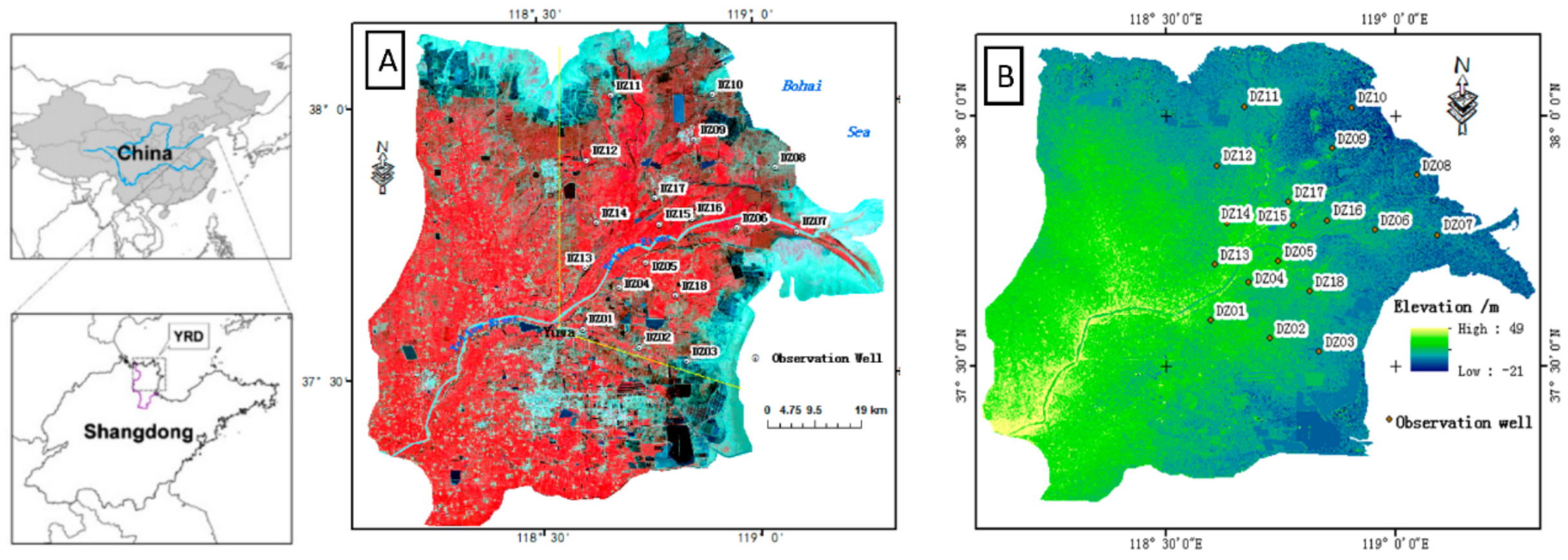


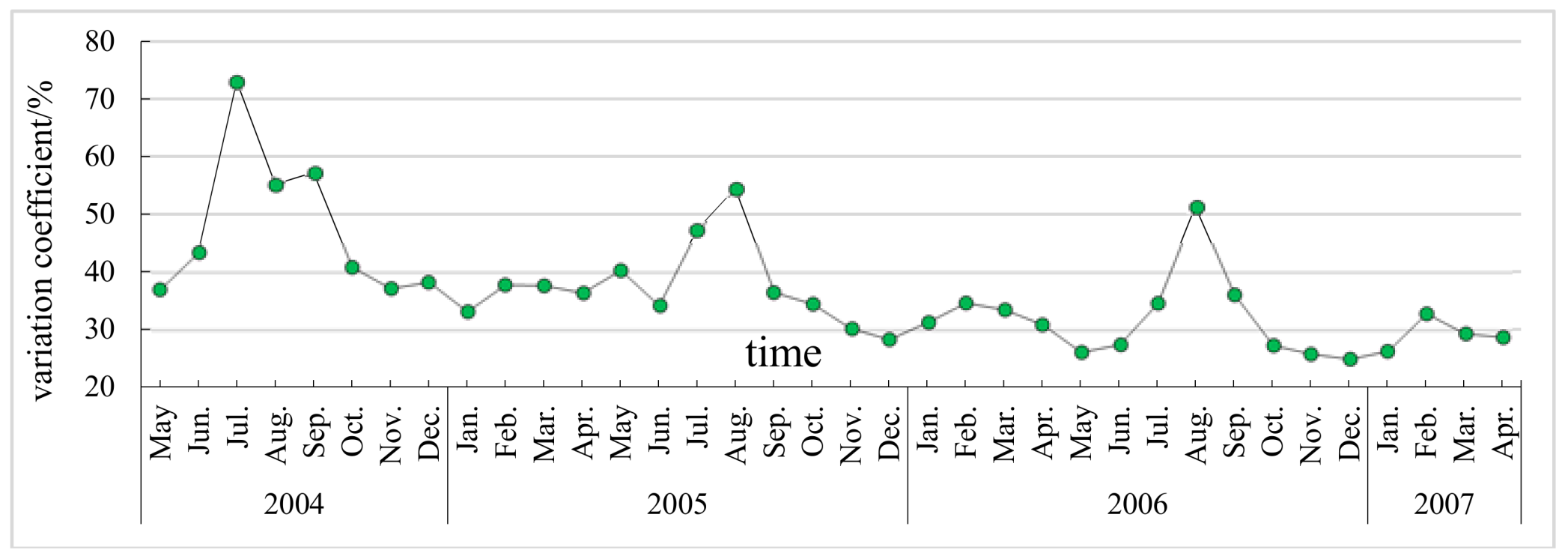



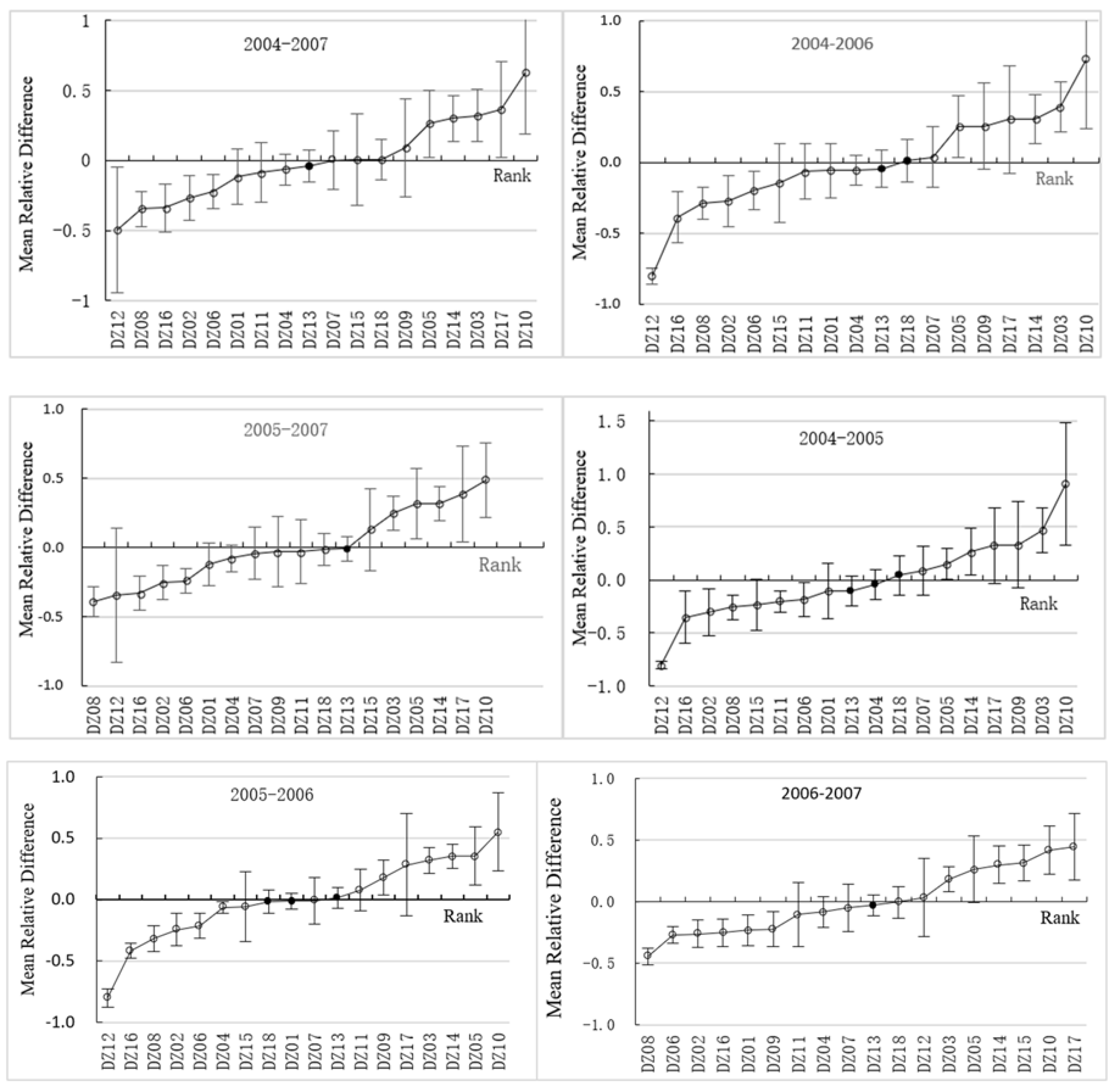
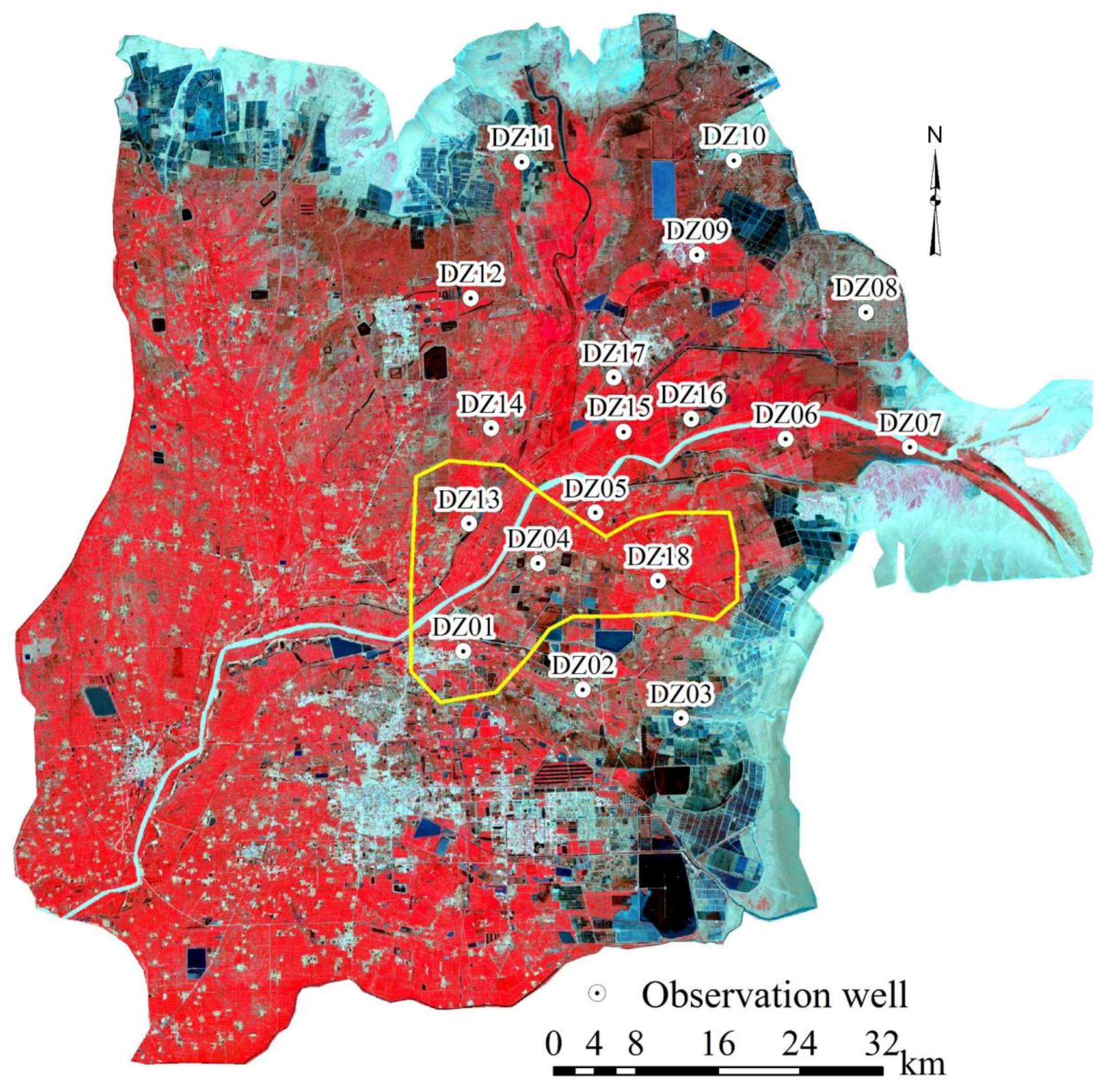

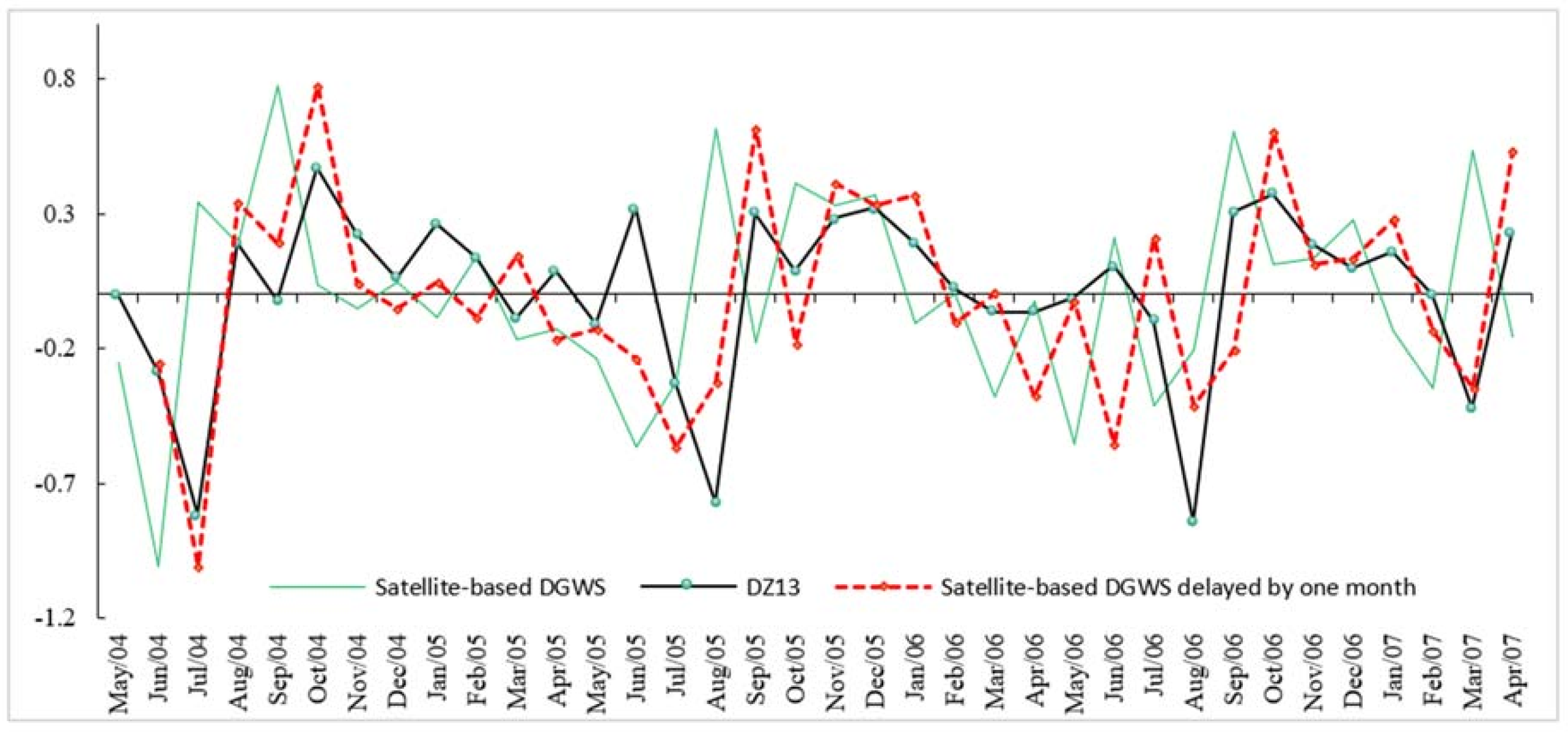
| Month | 2004–2005 | 2005–2006 | 2006–2007 | |||||||||
|---|---|---|---|---|---|---|---|---|---|---|---|---|
| May | August | December | February | April | August | December | February | April | August | December | February | |
| May | 1.000 | 0.521 * | 0.676 ** | 0.616 ** | 0.732 ** | 0.470 * | 0.299 | 0.443 * | 0.389 | 0.378 | 0.294 | 0.298 |
| August | 1.000 | 0.620 ** | 0.550 ** | 0.556 ** | 0.613 ** | 0.464 * | 0.342 | 0.461 * | 0.087 | −0.121 | 0.096 | |
| December | 1.000 | 0.953 ** | 0.876 ** | 0.753 ** | 0.673 ** | 0.732 ** | 0.645 ** | 0.518 * | 0.428 * | 0.531 * | ||
| February | 1.000 | 0.851 ** | 0.623 ** | 0.781 ** | 0.783 ** | 0.738 ** | 0.488 * | 0.455 * | 0.577 ** | |||
| April | 1.000 | 0.609 ** | 0.602 ** | 0.680 ** | 0.740 ** | 0.488 * | 0.329 | 0.476 * | ||||
| August | 1.000 | 0.549 ** | 0.644 ** | 0.449 * | 0.563 ** | 0.190 | 0.250 | |||||
| December | 1.000 | 0.874 ** | 0.874 ** | 0.488 * | 0.320 | 0.461 * | ||||||
| February | 1.000 | 0.866 ** | 0.775 ** | 0.579 ** | 0.635 ** | |||||||
| April | 1.000 | 0.539 * | 0.366 | 0.513 * | ||||||||
| August | 1.000 | 0.804 ** | 0.808 ** | |||||||||
| December | 1.000 | 0.833 ** | ||||||||||
| February | 1.000 | |||||||||||
| Sum/month | 17 | 16 | 24 | 24 | 25 | 20 | 24 | 30 | 20 | 16 | 12 | 12 |
| 2004-2005 | May | June | July | August | September | October | November | December | January | February | March | April |
|---|---|---|---|---|---|---|---|---|---|---|---|---|
| Pearson coefficient | −0.799 ** | −0.610 ** | −0.815 ** | −0.856 ** | −0.865 ** | −0.855 ** | −0.789 ** | −0.789 ** | −0.676 ** | −0.716 ** | −0.757 ** | −0.749 ** |
| 2005–2006 | May | June | July | August | September | October | November | December | January | February | March | April |
| Pearson coefficient | −0.781 ** | −0.691 ** | −0.778 ** | −0.754 ** | −0.722 ** | −0.745 ** | −0.676 ** | −0.712 ** | −0.740 ** | −0.758 ** | −0.540 ** | −0.438 ** |
| 2006–2007 | May | June | July | August | September | October | November | December | January | February | March | April |
| Pearson coefficient | −0.707 ** | −0.735 ** | −0.771 ** | −0.816 ** | −0.776 ** | −0.801 ** | −0.820 ** | −0.816 ** | −0.851 ** | −0.839 ** | −0.634 ** | −0.574 ** |
| Time Scale | Representative Locations | Unstable Locations | ||
|---|---|---|---|---|
| Well Code | Groundwater Depth Grade | Well Code | Groundwater Depthm and Grade | |
| 2004–2007 | DZ13 | medium | DZ12 and DZ10 | 0.95 higher and 2.60 lower |
| 2004–2006 | DZ13, DZ18 | medium | DZ12 and DZ10 | 0.95 higher and 2.60 lower |
| 2005–2007 | DZ13 | medium | DZ12 and DZ10 | 0.95 higher and 2.60 lower |
| 2004–2005 | DZ04, DZ13 and DZ18 | medium | DZ12 and DZ10 | 0.95 higher and 2.60 lower |
| 2005–2006 | DZ13, DZ01 and DZ18 | medium | DZ12 and DZ10 | 0.95 higher and 2.60 lower |
| May 2006–24 December 2007 | DZ13 | medium | DZ08 and DZ10 | 1.08 higher and 2.60 lower |
| Period | Pearson Correlation | Mean of the DZ13/m | Mean of the Region/m | Difference/m/m |
|---|---|---|---|---|
| 5 May 2004–28 April 2005 | 0.961 ** | 1.294 | 1.419 | 0.088 |
| 2 May 2005–27 April 2006 | 0.910 ** | 1.707 | 1.670 | −0.022 |
| 2 May 2006–2 December 2007 | 0.898 ** | 1.782 | 1.812 | 0.017 |
| 5 May 2004–27 April 2006 | 0.943 ** | 1.501 | 1.544 | 0.028 |
| 2 May 2005–2 December 2007 | 0 | 1.754 | 1.759 | 0.003 |
| 5 May 2004–2 December 2007 | 0.924 ** | 1.629 | 1.665 | 0.022 |
| Jpl | Gfz | Csr | DJpl | DGfz | DCsr | |
|---|---|---|---|---|---|---|
| DZ13 | 0.081 | −0.049 | 0.031 | 0.673 ** | 0.707 ** | 0.635 ** |
| All wells | 0.089 | −0.033 | 0.044 | 0.634 ** | 0.644 ** | 0.566 ** |
© 2018 by the authors. Licensee MDPI, Basel, Switzerland. This article is an open access article distributed under the terms and conditions of the Creative Commons Attribution (CC BY) license (http://creativecommons.org/licenses/by/4.0/).
Share and Cite
Wang, R.; Huston, S.; Li, Y.; Ma, H.; Peng, Y.; Ding, L. Temporal Stability of Groundwater Depth in the Contemporary Yellow River Delta, Eastern China. Sustainability 2018, 10, 2224. https://doi.org/10.3390/su10072224
Wang R, Huston S, Li Y, Ma H, Peng Y, Ding L. Temporal Stability of Groundwater Depth in the Contemporary Yellow River Delta, Eastern China. Sustainability. 2018; 10(7):2224. https://doi.org/10.3390/su10072224
Chicago/Turabian StyleWang, Ruiyan, Simon Huston, Yuhuan Li, Huiping Ma, Yang Peng, and Lihua Ding. 2018. "Temporal Stability of Groundwater Depth in the Contemporary Yellow River Delta, Eastern China" Sustainability 10, no. 7: 2224. https://doi.org/10.3390/su10072224





